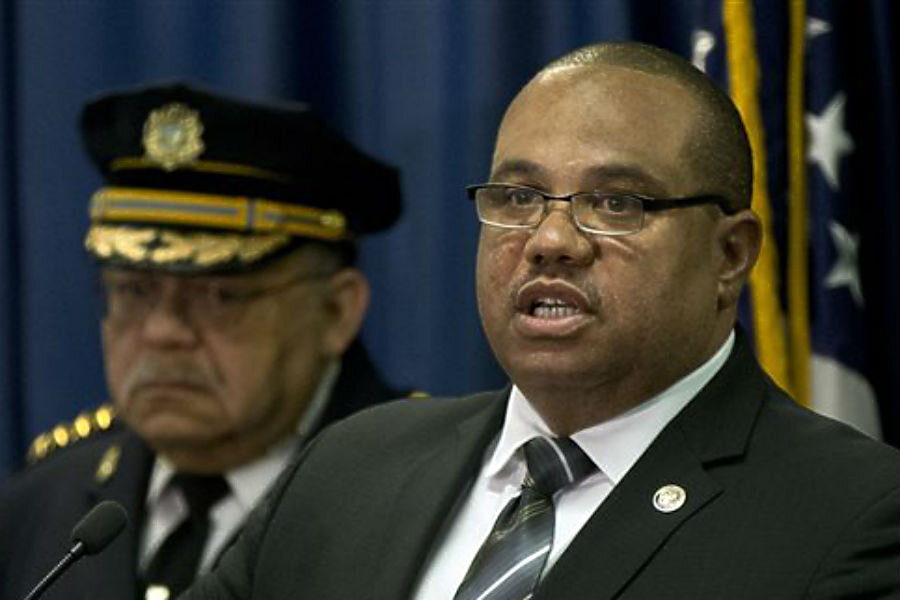Why Philadelphia police need reforms in wake of shootings
Loading...
| New York
Philadelphia police officers need better training in the use of force in the wake of nearly 400 shootings since 2007, a new Justice Department report found. Poor training, combined with a less-than-transparent review process of police shootings, has contributed to an "undercurrent of significant strife" between officers and the communities they serve, federal investigators found.
The federal probe of the Philadelphia Police Department comes as the nation’s municipal police forces continue to draw scrutiny across the country after a year of high-profile fatal shootings of unarmed men.
But unlike the Justice Department’s investigations into communities like Ferguson, Mo.; Cleveland; New Orleans; or over a dozen other cities, the Philadelphia probe came at the request of Commissioner Charles Ramsey, who has been head of the nation’s fourth-largest police force since 2008. After a spike of four straight days of police shootings in 2013, Philly’s top cop asked the federal government to investigate the department’s methods of policing.
Instead of federal prosecutors, the investigation was conducted by the Justice Department’s Community Oriented Policing Services (COPS), an office that works with law-enforcement agencies, assessing their methods and their relationships with communities.
Philadelphia police officers shot and killed 96 suspects between 2007 and 2014 – part of 394 officer-involved shootings over this time, the report found. The 174-page report issued almost 50 findings and more than 90 recommendations for the department. The Justice Department said it would work with Philadelphia over the next year and half to implement the voluntary reforms.
“It’s a good report with a lot of solid recommendations,” said Commissioner Ramsey at a press conference Monday afternoon. “These changes don’t happen overnight, but we’re going to push as hard as we can and make substantial changes over the next few months.”
The relative comity between the Philadelphia police and federal investigators on Monday, despite the critical findings, stands in stark contrast to the scathing federal report issued earlier this month about the Ferguson Police Department that documented a systematic white power structure that abused its black underclass. That report came after the shooting of a black teenager, Michael Brown, last August sparked months of protests.
Though outlining a host of deep-rooted systemic problems, the Justice Department’s COPS investigators did not find similar racial abuses in Philadelphia. Of the nearly 400 police shootings since 2007, about 60 percent of the officers firing their weapons were white, and 80 percent of the suspects were black, the report found. Just 15 percent of all suspects were unarmed.
Still, investigators found that whites shot by police were more likely than blacks to be unarmed. And in most instances, unarmed black suspects were shot by black officers. Yet nearly 9 percent of black suspects were shot because of a “threat perception failure,” the report found, almost three times the 3 percent of whites shot because officers wrongly concluded they posed a threat.
“It is clear that the Black community is disproportionately impacted by extreme violence involving the police,” the report concluded. “The department must remain cognizant of this fact and improve academy training to better prepare officers for policing in a multicultural society.”
But the report also noted that there are no reliable estimates about the overall rate of police shootings across the country. The nation's some 18,000 police agencies report specific categories of crime statistics each year to the FBI's Uniform Crime Reporting program, but reporting their justifiable homicides is optional.
“Therefore, we cannot say whether this number [of shootings in Philadelphia] is high or low,” the Justice report noted.
The report comes as community tensions remain high in the nation’s fifth-largest city after the death of Brandon Tate-Brown, a black man shot and killed by police in December. Last week, a Philadelphia prosecutor declined to bring charges against the officer, sparking angry protests and chants of “Black lives matter.”
Investigators found that Philadelphia police officers receive scant training on situations requiring the use of force, and that firearms training focuses on targets and street tactics. In addition, officers receive no training on non-lethal methods, such as Tasers and pepper spray. Weapons training is “too infrequent, lacks the appropriate concepts, and, at times, lacks standards," the report said.
“Incidents involving discourtesy, use of force, and allegations of bias by PPD officers leave segments of the community feeling disenfranchised and distrustful of the police department,” the Justice report found.
The report also found a troubling lack of transparency in the department’s investigations into officer-related shootings, since it does not release findings, or the names of the officers involved, in such incidents.
The Justice Department recommended the department overhaul its officer training procedures for the use of deadly force and form an independent agency to review the shootings of unarmed suspects.
"Segments of the Philadelphia community do not trust the agency or any local partners to conduct a fair and objective investigation of [police shootings], the report said. “This distrust stems from incidents in which members of the department have engaged in corruption and excessive uses of force and from the department’s lack of transparency on these matters.”






